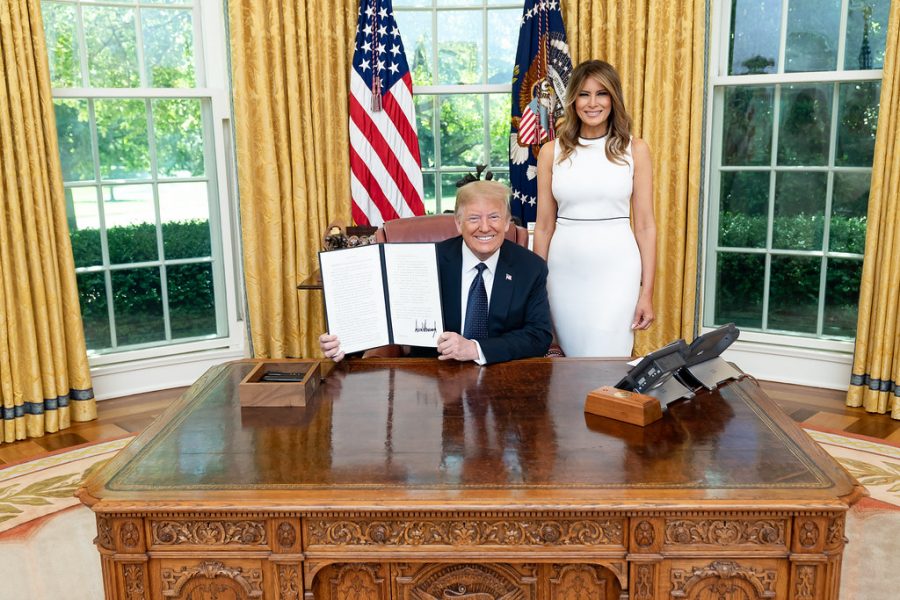Chung: Trump’s New Executive Order Won’t Make Much Progress on Police Reform
June 27, 2020
President Trump’s new executive order to make “real progress on public safety” is an inadequate policy that initiates no proximate action but merely outlines a set of guidelines to respond to the national uprising against racism and police brutality after the death of George Floyd. In response, Senate Minority Leader Chuck Schumer conveyed that “this executive order will not deliver the comprehensive meaningful change and accountability in our nation’s police departments that Americans are demanding.”
Schumer is right. Trump’s new edict attempts to address the importance of accountability of policing, hence proposing that the Attorney General create a national database to track police misconduct. However, the order does not take any real action on popular police reforms to increase accountability, defund law enforcement or create national use of force guidelines.
Increasing Accountability
Police brutality has been an ongoing problem and it undermines law enforcement accountability and public trust. Our nation has often tried to resolve the issue through enhancing transparency, but there hasn’t been enough progress.
In 1943, Robert Hall was beaten to death by three white police officers after he was charged with stealing a tire. A few years later, a panel established by President Harry Truman concluded that the “lawless police action” against Black Americans had a “dominant pattern” of “race prejudice.” More than 70 years later, that same pattern remains.
Trump’s new executive order attempts to create a national database to track police misconduct. But it ultimately falls short. The database would only include “when officers have been terminated or decertified, have been criminally convicted for on-duty conduct or faced civil judgments for improper use of force.” It would exclude “instances where a law enforcement officer resigns or retires while under active investigation related to the use of force” and requires the officer had been “afforded fair process” — without giving a clear definition of a fair process.
Defunding Police
Enhanced transparency is a crucial first step to improve best practice of policing, but by itself, is inadequate. Trump’s executive order, while putting minimal restrictions in place, does not reduce any “discretionary grant funding.” On top of that, he explicitly rejected the calls to reallocate police funding earlier this month saying “There won’t be defunding, there won’t be dismantling of our police and there is not going to be any disbanding of our police.”
Anthony D. Romero, Executive Director of the ACLU explained the importance of reallocation after the order was issued, “The federal government must stop grant programs that turn local police departments into standing armies and reallocate those resources into alternatives to policing that keep local communities safe and help them thrive.” Utah protestors also called for police defunding in the weeks long protests as well as during the virtual city council meeting.
Despite continuous calls from protestors, the executive order proposed a further investment into law enforcement by funding community-based policing programs, which involves engaging social workers as co-responders to the nonviolent issues including mental health, addiction and homelessness.
Social workers have been a big help to various communities during the COVID-19 pandemic and are oftentimes better equipped to be first responders than law enforcement. The homeless population is especially vulnerable to COVID-19 and also to police brutality. The Los Angeles Times found that “in 2019…officers used force on homeless people 217 times, a 26% increase from the same period in 2018.” Social workers can also better help people with mental illness who are “16 times more likely to be killed during a police encounter than other civilians approached or stopped by law enforcement.”
Some reports indicate that this co-responder program might help people with mental illness, substance addiction or are homeless. But tagging a social worker alongside the police is not going to create real punishments for police brutality.
Use-of-Force Policies
The executive order also addresses some force policies. There has been an overwhelming demand and support for a complete ban on chokeholds — George Floyd isn’t the first victim to shout “I can’t breathe” while slowly suffocating from police’s reckless abuse. Eric Garner also died from a police chokehold in July 2014. House Speaker Nancy Pelosi described chokehold as a practice of abuse, lynching and strangulation.
The order gives a huge amount of leeway and discretion to officers when it comes to using chokeholds by authorizing force “in those situations where the use of deadly force is allowed by law.”
Trump’s recent executive order is nowhere near what is needed to end police brutality and dramatically reform American law enforcement. If the government sincerely wanted to end police brutality and engage in police reform, it would pass real reforms to increase accountability, reallocate resources and reduce the use of force.







